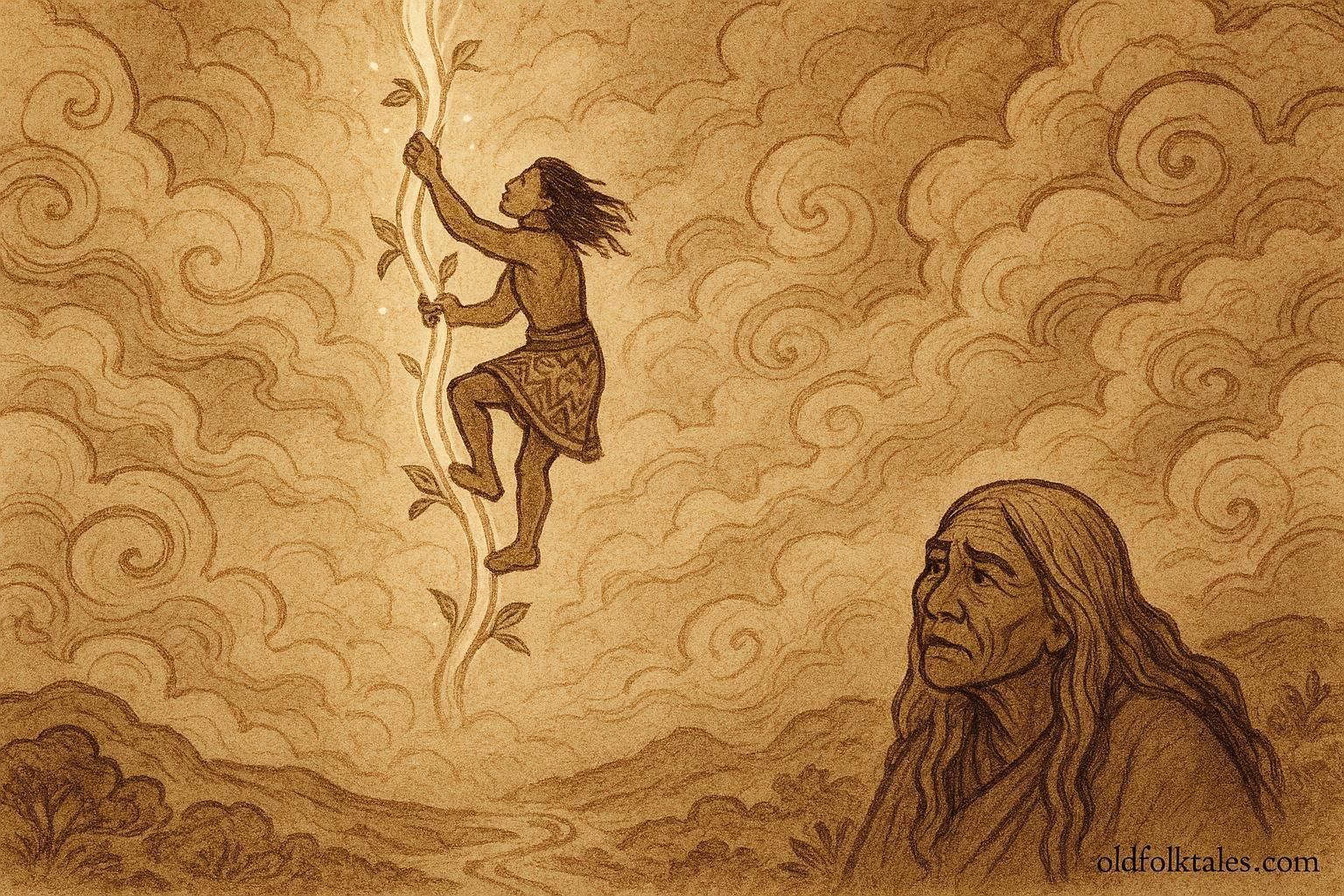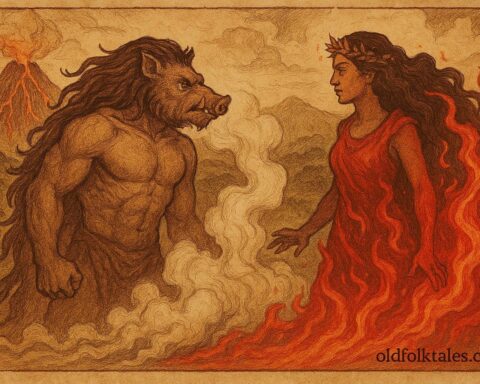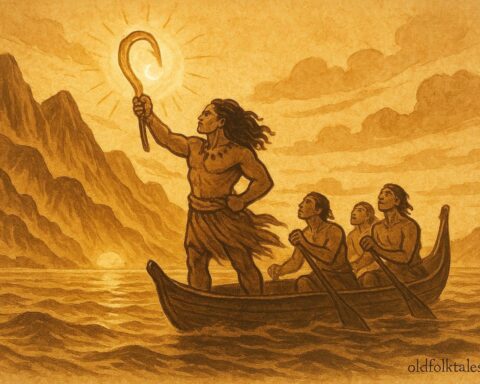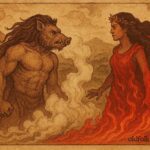Long ago in Aotearoa, before the world of men and gods was clearly divided, there lived a young man named Tāwhaki, born of both mortal and divine lineage. His mother descended from the sky beings, and his father, Hema, was a great chief among men, brave, kind, and loved by all who knew him.
But jealousy and cruelty often strike even in sacred bloodlines. Hema’s jealous kin plotted against him, and through deceit and violence, they caused his death. His son Tāwhaki, still young but noble in heart, wept for his father’s loss. The winds carried his grief through the forests and valleys, and the heavens themselves heard his cry.
From that day, Tāwhaki swore that he would journey beyond the earth to seek vengeance and knowledge, to find the realm of the gods where truth and justice were kept. His heart burned not only for retribution but for understanding, for he longed to see the face of the divine light that gave life to all things.
The Journey Begins
Tāwhaki set out alone through the ancient forests of Aotearoa. The tall rimu and kahikatea trees stood like silent guardians as he passed beneath their shade. Birds called out from the treetops, as though singing blessings for his courage.
After many days, Tāwhaki came upon a lonely hut perched near the roots of a great tree. An old woman sat there, her hair white as mountain mist. Her eyes glowed with the wisdom of countless seasons. Tāwhaki approached cautiously, for he knew this was no ordinary woman, she was his grandmother, Whaitiri, once the goddess of thunder.
She looked at him with sadness and pride. “You are Hema’s son,” she said. “I have waited for this day. The blood of the heavens flows in you. If you wish to climb to the gods, you must first know patience and courage, for the way upward is perilous.”
Tāwhaki bowed and said, “Grandmother, my father’s spirit cries for justice. Teach me how to reach the realm above, that I may honor him and restore our name.”
The Climb Toward Heaven
Whaitiri led him to the foot of a great vine that reached far into the clouds, a living bridge between the earth and the sky. It shimmered faintly, as if woven from light and mist. “This,” she said, “is the path to the heavens. But beware, my child, not every vine leads to truth. Some lead to death.”
She showed him the sacred vine, the Ara-tiatia, and whispered the karakia, ancient chants of ascent. Tāwhaki pressed his hands to the vine and began to climb. The wind howled around him, carrying voices of warning and doubt. Rain lashed his face, and thunder rolled in the distance. But he remembered his grandmother’s words: “Endure, and the heavens will open.”
As he climbed, he passed through many realms. The first was the Realm of Darkness, where the air was thick and heavy, and unseen spirits whispered temptations into his ear. Tāwhaki closed his eyes and kept his heart pure, refusing to answer.
Next came the Realm of Light, where dazzling brightness blinded him. Here he was tested not by fear, but by pride, for the gods offered him riches and power if he would forget his purpose. Yet Tāwhaki turned away, knowing that knowledge and justice were greater treasures.
At last, after what seemed an eternity, he emerged into the highest sky, the dwelling place of the gods. The heavens unfolded before him, vast fields of light, rivers of stars, and mountains that shone like jade. There, seated among the divine, was the ancestor he had sought: Tangotango, the celestial being from whom his family descended.
Tāwhaki’s Triumph
The gods watched as Tāwhaki approached. They saw the mortal determination in his eyes and the noble fire that refused to be dimmed. They spoke among themselves, saying, “Here is a child of both earth and sky. His courage is pure, and his purpose just.”
Tāwhaki bowed before Tangotango and spoke of his father’s death. The god listened in silence, then placed a hand upon his shoulder. “You have done what few mortals have dared,” he said. “You have climbed the vine of life and conquered both darkness and temptation. You have proven that the heart of humankind may reach even the heavens.”
Moved by his courage, the gods shared with Tāwhaki the sacred knowledge of light, the understanding of life’s rhythms, the power of speech, and the wisdom of creation. With this divine insight, Tāwhaki’s anger melted into peace. He saw that vengeance was not the path of enlightenment, only understanding could restore balance.
When his task was complete, Tāwhaki descended the vine back to earth. As he stepped once more upon the soil of his homeland, his people saw a radiance about him, the light of the heavens shining through mortal flesh.
From that day, Tāwhaki became a teacher and guide, passing on the knowledge he had gained. And when storms lit the night sky with flashes of lightning, the Māori people would say, “It is Tāwhaki, still climbing the heavens, carrying light to all who seek it.”
Moral Lesson
The Legend of Tāwhaki teaches that true strength lies not in revenge or pride, but in perseverance and wisdom. Through patience, courage, and humility, even mortals may touch the divine. Knowledge gained through struggle becomes a light that guides others toward harmony and understanding.
Knowledge Check (Q&A)
-
Who was Tāwhaki’s father, and why did he seek the heavens?
Tāwhaki’s father, Hema, was killed unjustly. Tāwhaki sought the heavens for vengeance and divine wisdom. -
What role did Whaitiri play in the story?
Whaitiri, Tāwhaki’s grandmother, guided him to the sacred vine and taught him the chants for his ascent. -
What challenges did Tāwhaki face during his climb?
He faced darkness, temptation, and blinding light, tests of courage, purity, and humility. -
What did Tāwhaki gain from reaching the heavens?
He received divine knowledge and enlightenment, realizing that peace was greater than vengeance. -
What does Tāwhaki symbolize in Māori culture?
Tāwhaki represents the human pursuit of wisdom, perseverance, and the bridge between mortal and divine realms. -
How is Tāwhaki remembered in nature?
Lightning and storms are said to be Tāwhaki’s ongoing ascent, bringing light and knowledge to the world.
Source: Adapted from The Lore of the Whare-Wānanga by H.T. Whatahoro (translated by S. Percy Smith, 1913).
Cultural Origin: Māori (Aotearoa/New Zealand)












